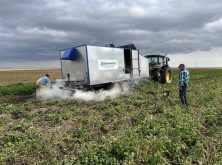Western Canada has a kochia problem. It’s probably because kochia can tolerate things such as drought or salinity better than most crops; which allows it to proliferate in many areas of fields where the crop is less competitive. Kochia is one of the first weeds to emerge in spring and continues to grow until the first killing frost. Green kochia patches can be seen in a variety of crops at this time of year, often as patches in low-lying areas.
Read Also

Cancer agency reclassifies another herbicide ‘probably carcinogenic’
The WHO’s cancer research agency has now put atrazine, a herbicide well known to corn growers, in the same potential-hazard category where the agency put glyphosate.
The Weed Ecology and Cropping Systems research program at Agriculture and Agri-Food Canada Lethbridge offers a free testing service to confirm glyphosate (Group 9) or auxinic (Group 4) herbicide resistance in kochia. If you suspect resistance in kochia to either of these herbicide modes of action, we can confirm that for you. The test requires about 1,000 viable seed from the kochia population. If you would like to take advantage of this service, please contact me by email at [email protected] or by phone 403-359-6969 for more information.
More about kochia
Populations of kochia remain green at harvest time, which can hinder harvest operations. There are four general options used to deal with green patches of kochia during harvest. The first option is to continue with harvest as usual but that can result in harvest equipment plugging by an abundance of green tissue. The impact of green tissue during harvest, however, is dependent on the density of green plants fed into the machine. Swathing (option two) before harvest can cut off green kochia biomass and allow the weed to dry in the swath prior to harvest.
When harvesting directly, a pre-harvest herbicide application (option three) can help dry the green kochia biomass and aid with harvest operations. This often results in the crop standing in the field for a longer period while the herbicide takes effect. When using a pre-harvest herbicide application, carefully consider the crop stage growth and development. For example, apply glyphosate only after seed moisture reaches less than 30 per cent (see your Guide to Crop Protection for further description on staging for each crop) to ensure that the harvested seed remains under the maximum residue limits for glyphosate.
Many growers harvest around kochia patches and leave the weed standing in the field until after harvest (option four). These patches are often cut after harvest, baled and used for animal feed. Be careful when you use this option because no one know the exact stage when kochia seed becomes viable and seed production begins in late August or early September.
My new research in Western Canada will evaluate when kochia plants begin to produce seed, and when this seed becomes viable. This research will also test how timing of cutting kochia patches and herbicide use before or after cutting kochia impact kochia seed production and viability. This work will provide information on timing of kochia seed production under a variety of management scenarios, and help growers decide how to manage patches of this weed.
Using cut kochia in livestock feed could spread viable seeds to new areas and those seeds might have herbicide-resistance traits like glyphosate-resistance. The seeds may spread during transport or may survive rumen digestion and spread during manure application. Dr. Bob Blackshaw (AAFC Lethbridge, retired) conducted research that showed you can turn kochia into silage, feed it to cattle and still have 10 per cent viable seed in manure. With 30,000 seeds per kochia plant, a lot of kochia seed can remain viable in livestock manure. It is unclear whether the small amount of composting that occurs during manure piling can impact seed viability.
Growers need to remain diligent when importing animal feed onto their farm that they don’t also import viable glyphosate-resistant kochia seed. Try to cut kochia patches before it produces viable seed.















